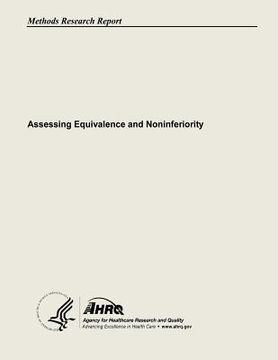Reseña del libro "Assessing Equivalence and Noninferiority (en Inglés)"
This publication provides guidance to EPCs about several issues on equivalence and noninferiority. This guidance is urgent for many reasons. First, comparative effectiveness research (CER) involves comparing active treatments, and these comparisons often suggest equivalence. What kinds of data permit a valid conclusion of equivalence? As CER receives greater prominence in critical medical decisions, evidence reviewers need clear and consistent guidelines for concluding equivalence. The same is true for individual trialists. However, our perspective is that of a systematic reviewer confronted with multiple trials making the same active comparison. A second reason for urgency is that the medical literature has seen a recent increase in the number of trials actually defining themselves as "equivalence trials" or "noninferiority trials." How should evidence reviewers incorporate such trials? Third, the wider field of systematic review has no guidance on equivalence and noninferiority. Some guidance exists from regulatory agencies and academia, but these are targeted to individual trialists, not reviewers. Fourth, systematic reviewers vary greatly in their choice of language for concluding equivalence or noninferiority (e.g., "similar effects," "no evidence of a difference," "evidence of no difference," "evidence does not suggest a difference," "treatment A is not worse," "treatment A is not superior," etc.). This variation is confusing and possibly misleading to users. Before presenting our methods and guidance, we briefly discuss the difference between "equivalence" trials (EQ) and "noninferiority" (NI) trials. These trials share the concept of ruling out the possibility of an important effect. They differ, however, in the typical clinical context and the permissible conclusions. EQ trials aim to determine whether a new treatment is therapeutically similar to a standard treatment within a predefined margin of equivalence (e.g., a ratio of plasma drug levels from 80 percent to 125 percent is used by FDA to establish bioequivalence). In contrast, NI trials are conducted in a clinical context of the assumption that a newer treatment (which we call the "test intervention") is superior to an older treatment (which we call the "active comparator") on certain outcomes unrelated to effectiveness (e.g., fewer side effects, lower cost, and/or greater convenience). This assumption sets the stage for being willing to accept a small decrement regarding the effectiveness of the test intervention. Thus, NI trials aim to determine whether the test intervention is not less effective than the active comparator by a prespecified amount. For example, Aujensky et al. conducted a noninferiority trial comparing outpatient to inpatient care for patients with acute pulmonary embolism. Outpatient treatment entails fewer costs, and thus some minimal reduced effectiveness may be acceptable (which the authors defined as no more than 4 percent increased rate of symptomatic recurrent venous thromboembolism within 90 days). Despite the contextual differences between EQ and NI trials, many details about their design and analysis are similar (e.g., the prespecification of a decision threshold). Thus, for ease of exposition, this guidance document refers to them collectively as "EQ-NI" trials, or refers to reviewers' conclusions as "EQ-NI" conclusions. Any areas where systematic reviewers should treat them differently are delineated in the pertinent sections of the guidance.

